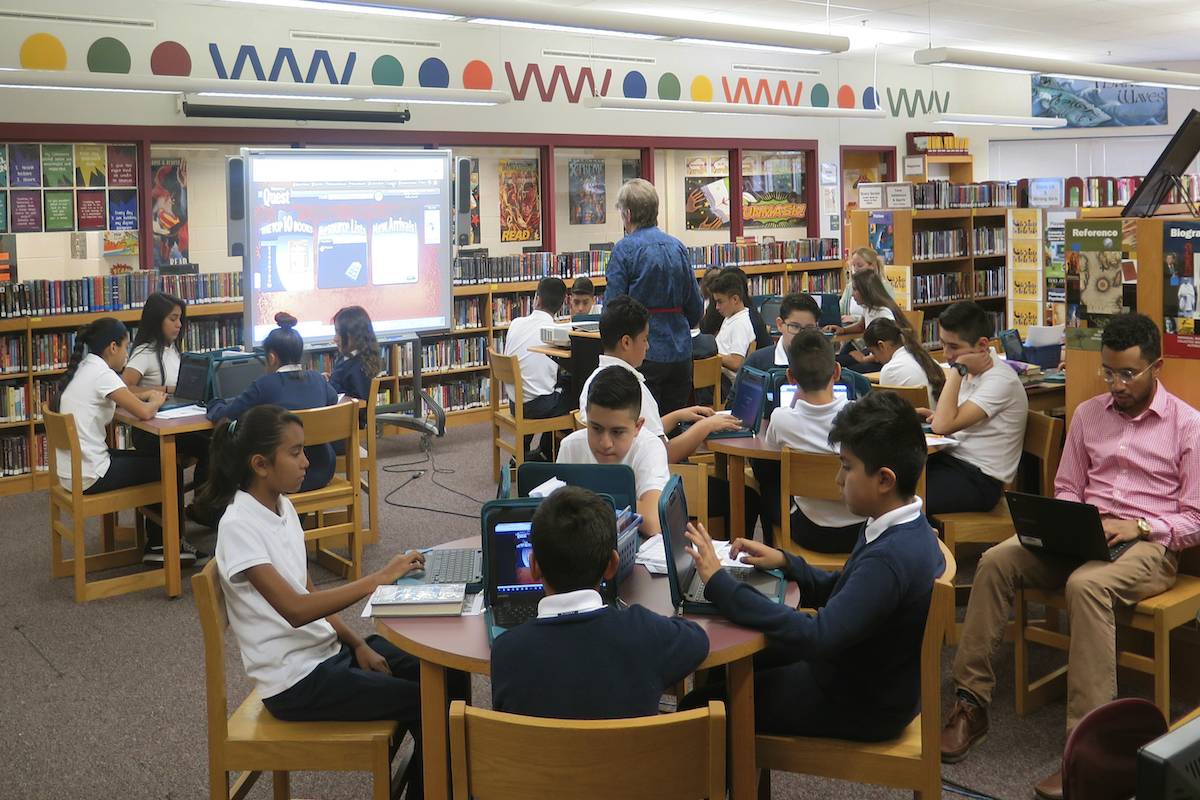

In this photo taken September 27, 2017 file photo from Milwaukee, students in the library at Bruce-Guadalupe Community School learn about searching for books and keeping track of what they’ve read. Bruce-Guadalupe is 97 percent Latino. (AP Photo/Ivan Moreno)
By Amanda Fernandez
Seventy-five years ago, five Latino families in California organized and launched a legal effort to ensure their children would have equal access to the same schools and resources as white families. While the fight for education equity pre-dates Mendez vs Westminster and goes far beyond it, this particular parent-led effort would go on to be cited in the historic Supreme Court decision, Brown v. Board of Education, that effectively banned school segregation. Fast forward to today, Black and Latino families continue to experience an education system that is separate and unequal as schools that serve majority Latino students are still denied the same academic opportunities given to white students.
We find ourselves in the same fight decades later because reform efforts have tinkered around the edges rather than tackling the inherent inequality that our education system was built upon. And in those 75 years, the number of Latino students in our public education system has grown significantly, but their needs and voices have been absent in the national conversation about education equity.
Latinos represent the fastest-growing share of the U.S. labor force. Our educational attainment is intrinsically tied to the future of this nation. In his American Families Plan, President Biden stresses the importance of investing in education to ensure economic growth and our ability to compete in the 21st-century global economy. While this proposal is critically important, it will only produce significant change if it is centered on Black, Latino and immigrant students.
For example, President Biden has proposed universal pre-K for all three- and four-year-olds. Greater access to high-quality preschool is critical for Latino children, who are among the population least served by these programs. Ensuring our youngest children have meaningful access to high-quality preschool, however, involves more than simply making the programs free. It means taking the time to meet parents and families where they’re at by providing information and resources in languages and formats that are easily accessible to our communities. It also requires that programs for Latino children have adequate student-to-teacher ratios; high standards and curricula support; and a professional, prepared, and well-compensated workforce that reflects their backgrounds and experiences.
In our national principles for a Latino education agenda, we called for a comprehensive and integrated approach to increasing pathways for Latinos to enter the educator workforce. Latino students will soon represent 30 percent of all students in our nation’s public schools, but Latino educators only make up 9 percent of all educators. An increase in representation is crucial for education equity because teachers of color have shown to build better trust with their students, improve academic performance of students, and serve as positive role models for students of color. During the pandemic, the diversity of educators has become even more important. As teachers balance educating and navigating the impacts of the pandemic, they must understand the community their students live in, the language families prefer to communicate in, and —yes— the real needs that students have which can impede learning, such as social-emotional support, food security, and housing. This requires a level of cultural competency and community connection that our schools must be equipped to provide.
President Biden recognizes this and has made a commitment to improve educator diversity in the American Families Plan, but we need Congress to make a similar commitment. Congress must provide incentives for states to work with higher education institutions, nonprofit organizations and legislators in support of a comprehensive plan that addresses the barriers facing Latino educators and provides consistent access and support to not only prepare Latinos for the profession but also to thrive and lead in it.
When it comes to college education, again, the President’s commitment to providing two years of free post-high school education is important. We also recognize his commitment to ensuring access to postsecondary education for DREAMers. A commitment to covering two years of community college is a good first step, but we must also ensure that Black and Latino students are set up for success as they navigate their post-secondary options. Investments in early college programs are proving to be an important lever for increasing rates of Black and Latino students entering college. We need similar investments and other supports to ensure that our students are in a position to effectively take advantage of the opportunity for free postsecondary education.
Last year, President Biden committed to taking action on our national principles for Latino Education when elected, and we have seen him deliver on some of this promise. Now it’s important that Congress pass the American Families Plan with Latino students and our future workforce in mind. It is time to finish the work that those five families in Orange County started over 75 years ago, and we hope we can count on the Biden Administration and Congress to finally build an education system that is truly equal and just for Latino students.
***
Amanda Fernandez is CEO and co-founder of Latinos for Education. Twitter: @AmanFernan24.



Sure. But to pay for all these magical things we must immediately close our southern border. We must be vigilant in going after all employers that continue to employ people off the books. Bec everyone must start paying their fair share. All taxes Including federal. Maybe two income households so everyone contributes. And maybe we could look into taxing remittances. If this is even a start, I’ll be on board.